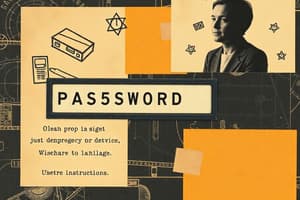Podcast
Questions and Answers
What is the purpose of the first while loop in the program?
What is the purpose of the first while loop in the program?
- To check if the number is a palindrome.
- To reverse the number.
- To print the original number.
- To find the sum of the digits. (correct)
In the context of this code, what happens if the number entered is 121?
In the context of this code, what happens if the number entered is 121?
- It will acknowledge 121 as not a palindrome.
- The reverse will be 121. (correct)
- The sum of digits will be 4.
- The program will not compile.
What value does the variable 'reverse' hold at the beginning of the program?
What value does the variable 'reverse' hold at the beginning of the program?
- The value of `num`
- 0 (correct)
- 1
- The sum of digits
What will be printed if the entered number is not a palindrome?
What will be printed if the entered number is not a palindrome?
Which variable stores the number temporarily while calculating the sum of its digits?
Which variable stores the number temporarily while calculating the sum of its digits?
What is the sum of the digits of the number 12?
What is the sum of the digits of the number 12?
What is the reverse of the number 212?
What is the reverse of the number 212?
Which statement is true for the number 12?
Which statement is true for the number 12?
How is a number defined as a palindrome?
How is a number defined as a palindrome?
What is the sum of the digits of the number 212?
What is the sum of the digits of the number 212?
Flashcards are hidden until you start studying
Study Notes
C Program for Digit Operations
- Program prompts user for a number input and calculates various properties of the number.
- Utilizes standard I/O functions
printfandscanffor interaction.
Sum of Digits
- Initializes
sumto zero and uses a temporary variabletempto hold the number. - A loop iterates while
tempis not zero:- Adds the last digit of
temptosumusingtemp % 10. - Reduces
tempby removing the last digit usingtemp /= 10.
- Adds the last digit of
- Example: Input of 12 results in a sum of digits equal to 3.
Reverse of the Number
- Initializes
reverseto zero and resetstempto the original number. - A loop constructs the reversed number:
- Multiplies
reverseby 10 and adds the last digit oftemp. - Updates
tempto remove the last digit.
- Multiplies
- Example: For input 12, the reversed number is 21.
Palindrome Check
- Compares the original number with the reversed number.
- If they are equal, prints that the number is a palindrome.
- Example: Input 212 is equal to its reverse, confirming it as a palindrome.
Program Output Example
- For input 12:
- Outputs sum of digits as 3.
- Outputs reversed number as 21.
- States that 12 is not a palindrome.
- For input 212:
- Outputs sum of digits as 5.
- Outputs reversed number as 212.
- Confirms that 212 is a palindrome.
Studying That Suits You
Use AI to generate personalized quizzes and flashcards to suit your learning preferences.




